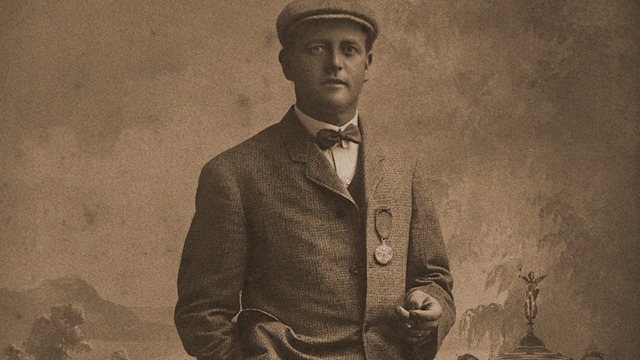Game Changers
When the Wanamaker Trophy Went Missing: Part 2
By David A, Mackesey
Published on
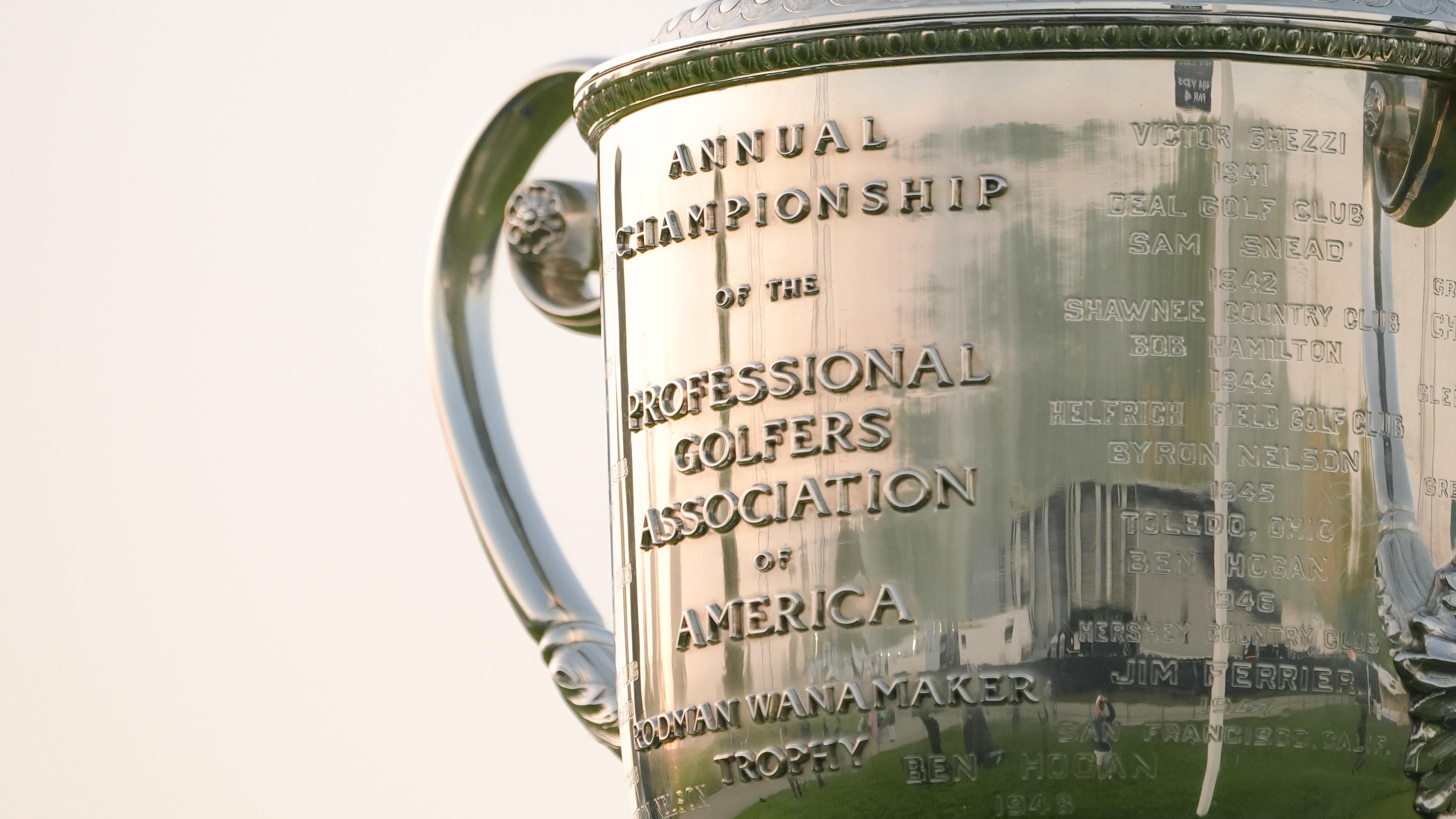
"THE WANAMAKER IS GONE, MR. PIRIE, WHAT SHALL WE DO?"
It's early October, 1928, after the semi-final matches to the PGA Championship.
For the first time in half a decade, Walter Hagen lost a match in the annual PGA Championship, and the golf world was shocked. More shocking, a tightly held secret just came to light: Hagen lost the Wanamaker Trophy.
He felt horribly, but it’s not like he gave anyone else a chance to lose it. Hagen held an iron grip on the PGA Championship, winning it five times, and the last four years in-a-row. Another surprise, he didn’t just lose it this week, he lost it at least a year prior. By his logic, as long as he kept winning, his secret was safe. The last public photo of the trophy was Walter holding it, beaming with pride, at Salisbury Country Club in 1926.

Walter Hagen being presented the Wanamaker Trophy, September 25 1926. Left to right, Leo Diegel, runner-up, George Sargent, PGA President, J. J. Lannin, owner, Salisbury CountryClub, Jack Hagen, Club Professional (no relation) and Walter Hagen.
Now obvious to a small group of PGA volunteer leaders, there would be no Wanamaker Trophy to present. Something had to be done, and fast. The buck stopped with one man, and whether he liked it or not, that man was 1928 PGA President, Alex Newton Pirie. The fifty-two year old had precious little time to discover if life had prepared him well to meet this challenge.
Born in Edinburgh, and raised in St. Andrews, he was amongst the early golf professionals immigrating across the Atlantic to America. A tight bond formed over the years between the fellow Scottish professionals, and when together over dinner, the scotch burrs dropped so thick about the table they bounced in the soup.
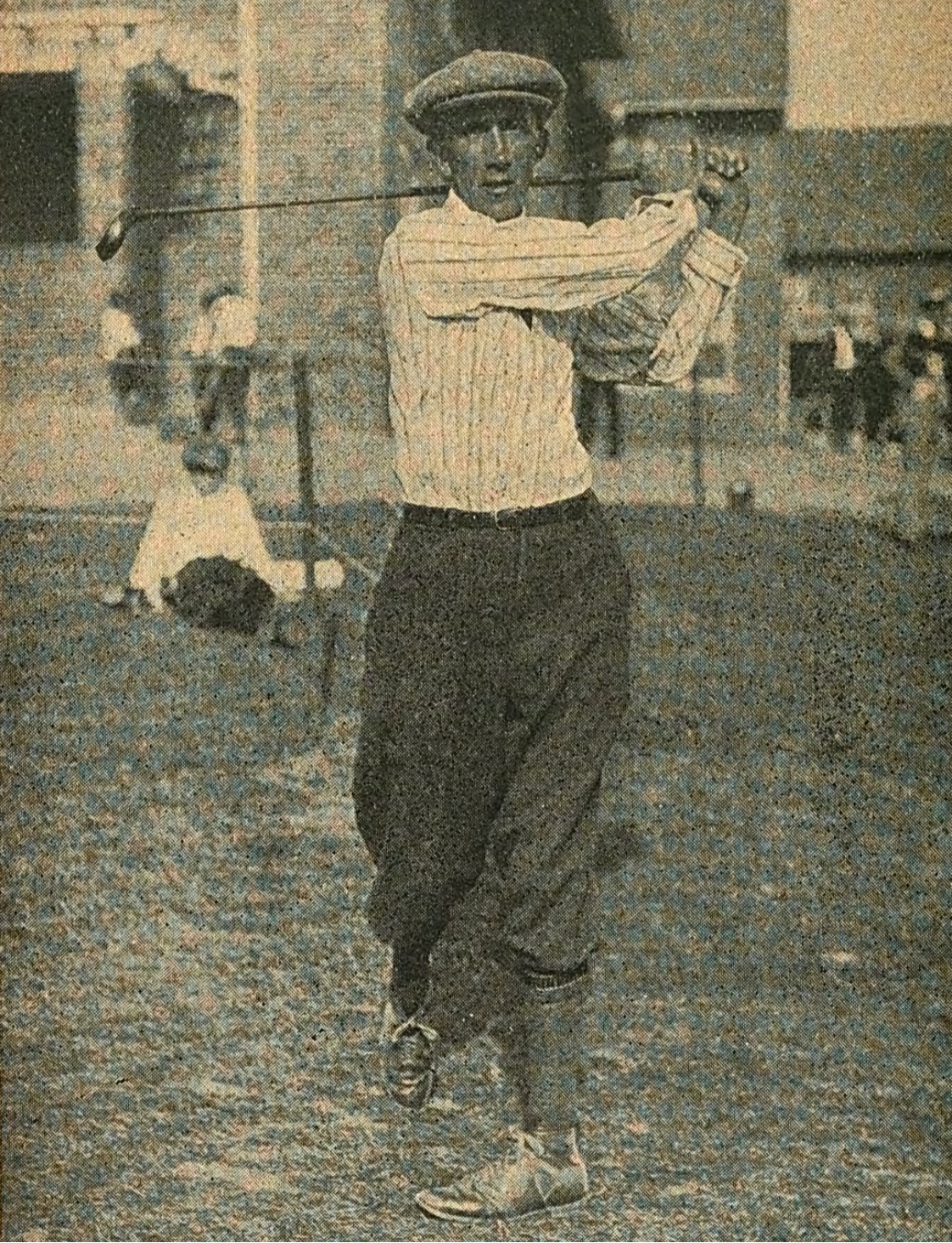
Alex Pirie, who was PGA of America President during the time of the lost Wanamaker Trophy.
While tall, Pirie was quite slender in build, which often forced him into doing a little bit more on the golf course, with a little bit less. He played in the early professional golf tournaments against stronger men than him, the likes of fellow Scots, and multiple-time U. S. Open Champions Willie Anderson and Alex Smith.
In 48 hours, the eyes of the golfing world will be upon Pirie, as master of ceremonies. Like playing in an alternate-shot Scotch golf match gone terribly wrong, Pirie’s imaginary partner just plunked him down in the toughest of predicaments. Being his shot, he simply had to play it where it lies.
The championship day arrived, and a new king of American professional golf will be crowned. Thousands of enthusiastic local golf fanatics bought tickets to follow the match, and cap it off in a formal ceremony immediately following. No surprise, Baltimore Country Club pulled out all the stops in an attempt to make it the best PGA Championship ever. The Mayor of Baltimore himself will be the keynote presenter, excited about the photo opportunity with the champion and the trophy.
The brotherhood of PGA of America Golf Professionals would support Alex Pirie however badly the next hour may turn out . . . and it was time for the ceremony. Behind the scenes, Pirie and the Baltimore Country Club crafted a make-shift solution. Inside the clubhouse, the impressive Maryland Cup trophy might just do the trick as a temporary stand-in. Solid silver, 30 inches tall and almost as wide, the press and the mayor might be satisfied. Leo Diegel, the new PGA Champion, and runner-up Al Espinosa played along to make the best of the awkward moment.
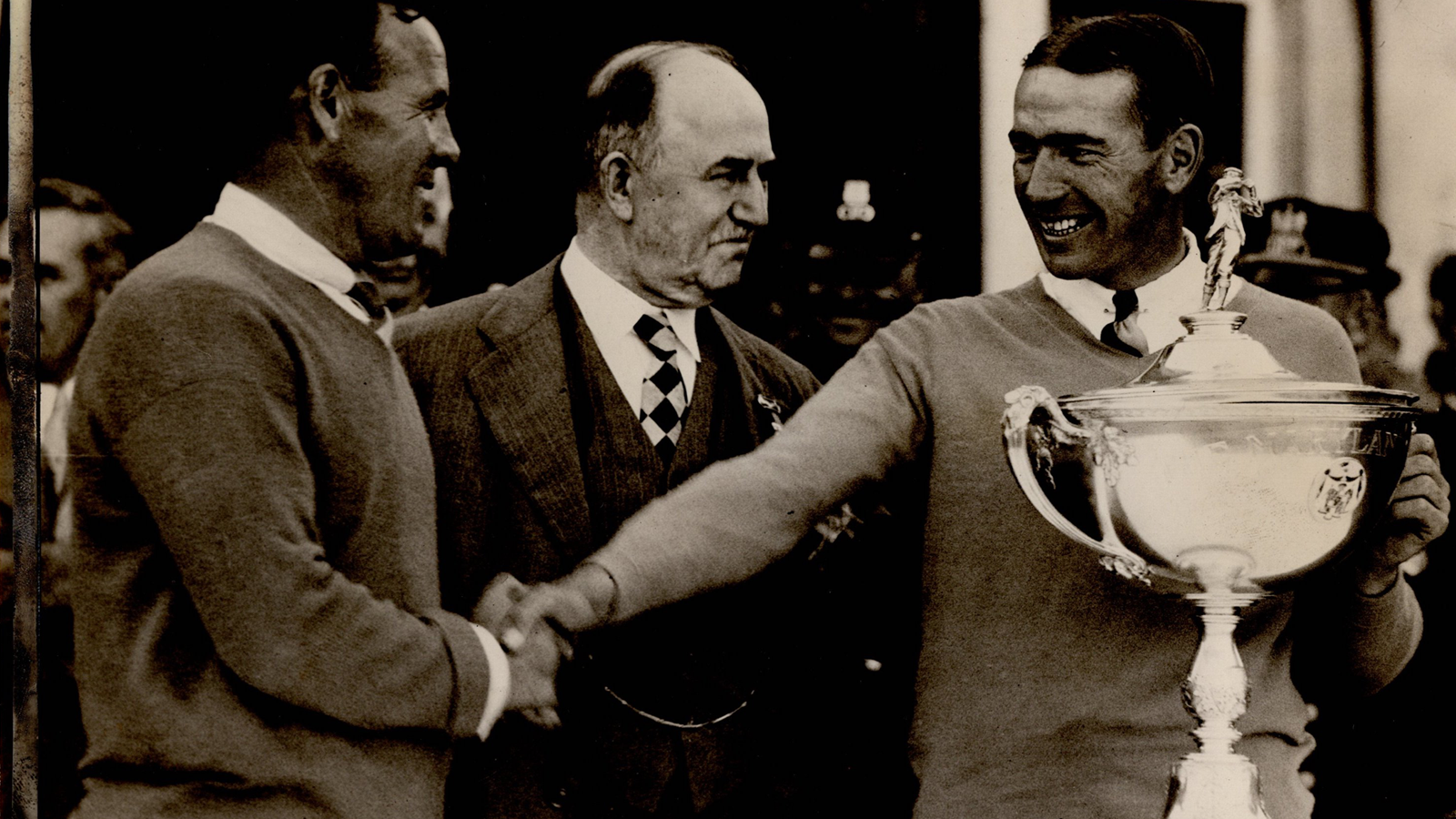
Left to right: Al Espinosa (runner-up), Broening (Baltimore Mayor) and Leo Diegel (1928 PGA Champion) holding the stand-in Maryland Cup Trophy.
Forced smiles around, and Mayor Broening presented the stand-in trophy bellowing, “I hope that those who have been privileged to play over this course have caught an inspiration from it . . . our people are an open-hearted people and we want you to carry away the love we have shown you.”
Alex Pirie, adding to Mayor Broening’s address, shared, “Twenty nine years ago, Baltimore and Baltimore Country Club held a national open and thereby qualified among the pioneers of American golf.. He praised the local officials, the course, the city and the fans declaring, “I never have been anywhere where I found a fairer a more hospitable, a more gentlemanly people than here.”
In thanks, Diegel proclaimed, “Would I like to see the National Open come here in 1930? And how!”
The local and national press cooperated, featuring images of the champion, the stand-in trophy, the Mayor of Baltimore, all without even the slightest mention of the missing Wanamaker Trophy. Well played by Alex Pirie, but he knew the fix was temporary, and the problem now required a permanent solution.
Weeks later, at the PGA Annual Meeting, the lost Wanamaker Trophy was only one of the many challenges before the organization. On the agenda, Pirie was duly elected to a third, well earned one-year term, but not before annual dues were doubled from $5 to $10. With approximately 2,000 members, this allowed for enough money to improve the operation, and hire a secretary to handle the administrative duties of this fast growing volunteer organization.
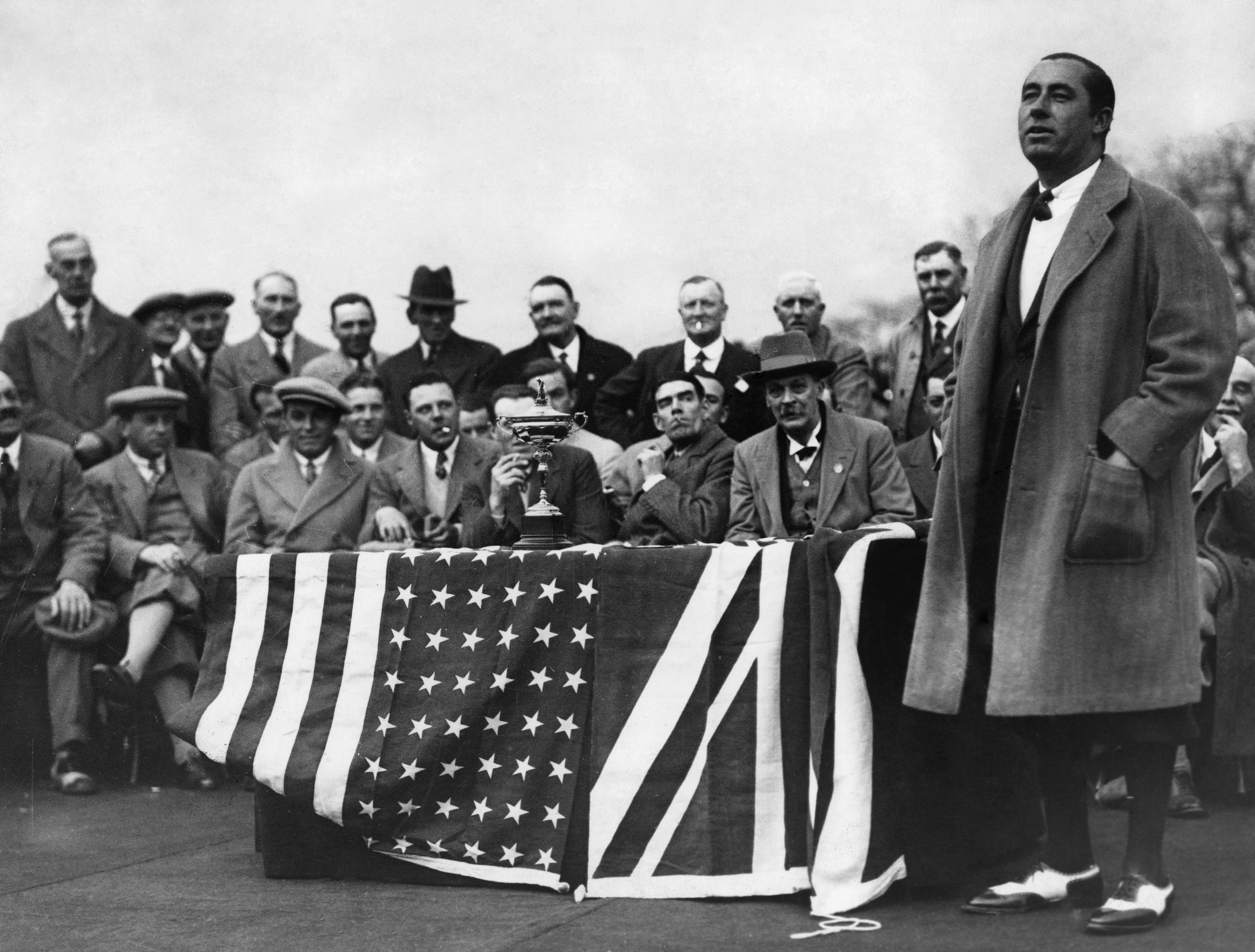
Walter Hagen at the Ryder Cup.
Hagen was again voted Captain for the U.S. Ryder Cup Team, but certainly the trophy would stay in PGA hands. In a surprise move, Santa Barbara was selected as the site of the 1929 Championship. To coincide with the growing west-coast professional golf winter season, the first week of December was agreed on, falling between the November Hawaii Open, and the January Los Angeles and Agua Caliente Opens. The 1920's were roaring, and this would be the richest three month span in golf history, over $70,000 in prize purses were offered, and every American golf professional would be in the west to earn their share. As an added incentive, the 64 qualifiers for the PGA Championship would receive a stipend for one-way train travel, to cover half the player’s transit expenses.
Not even earning an official footnote, the meeting ended with no agenda action on the trophy matter.
In January, Pirie made a formal visit to Santa Barbara to visit La Cumbre Country Club, wise and proper and due diligence for the site of the next Championship. The club, the sponsors, the golf course and the PGA were all in agreement, the 1929 event will be spectacular. What could go wrong?
Tuesday, Sept. 3, 1929 started innocently enough, until Pirie received the news. Just 12 weeks from the start of the championship, La Cumbre Country Club abruptly announced they would not host the event. A telegram confirming the decision from the Club President to the PGA office made it final. The uncertainty of financial sponsors and money guarantees was simply too great a risk. Once again, Pirie found himself in a tight predicament, and again, it was his play.
This problem was 2000 miles and several days travel away from Chicago, with no time to waste. Pirie placed this matter in the hands of a fellow PGA of America Board Member, Los Angeles based PGA Vice-President Jay "Pat" Patterson. The task? find a Southern California championship-quality golf course, find deep pockets as sponsors, get the press on your side, and do it last week.
Now obvious to a small group of PGA volunteer leaders, there would be no Wanamaker Trophy to present. Something had to be done, and fast. The buck stopped with 1928 PGA President, Alex Pirie.
Pat enlisted Leo Diegel to serve as his operating partner. After all, Leo was now working locally, the defending champion and well respected in golf circles and with the new Hollywood crowd.
He was the personal golf coach to movie magnates Joseph Schenck and Adolph Zukor. Schenck immediately agreed, and made the $10,400 personal guarantee. He then recruited 100 of Southern California’s most passionate golf supporters to purchase 20 tournament tickets at $5 each, securing an even $10,000 as backup. Nearby Hillcrest Country Club stood ready, and became the natural choice. The golf course was championship quality, the golf professional, Lewis Scott was top notch, the Board of Directors supportive, and the membership enthusiasm was through the roof.
A final exchange of telegrams, and Pirie agreed. By the first week of October, the Hillcrest announcement was official. The show will go on. Still much work to be done, but there was an uneasy calm in the air, a calm that barely lasted to the last week of Oct. 1929.
A pesky stock market crash would not halt this PGA Championship. Schenck and his fellow sponsors stood firm, and rallied even more support around Patterson. The matter of the lost Wanamaker Trophy remained under the radar, and executives from the iconic Majestic Radio Company stepped in to offer a beautiful top-of-the-line radio/phonograph as the Champion’s trophy prize, with a silver plate attached for engraving. The press promoted the idea, the players didn’t fight it, and this unique grand prize stood proudly at Hillcrest for all to admire during tournament week.
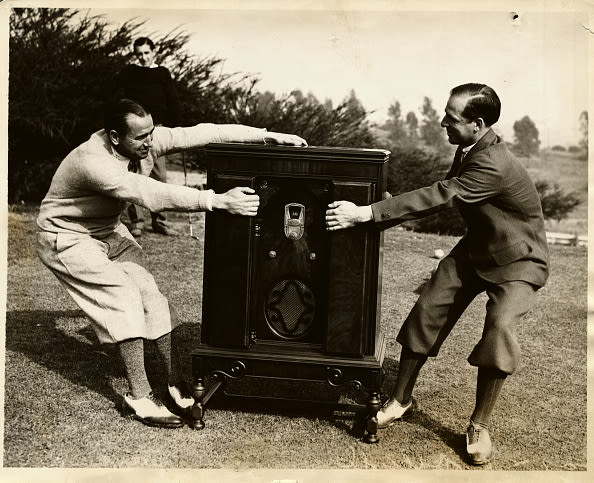
Leo Diegel in a tug-of-war pose with the Majestic Radio prize for the 1929 PGA Championship.
All the while, behind the scenes, Pirie quietly pursued the creation of the new PGA Championship trophy. A premier American silversmith from Wallingford, Connecticut, R. Wallace and Sons, was already making a splash in the trophy business. Custom trophies for Charles Lindbergh in aviation, and Major Henry Segrave in automotive speed records, made R. Wallace famous across America, and Pirie took note. The Los Angeles Open and Southern California PGA currently used R. Wallace’s other award designs with great success.
For the PGA of America, the R.Wallace large loving cup, solid silver, gold lined with a bright finish was perfect. A wide front field could accommodate full engraving to include the tournament year, winner, runner-up, match final score and the name of the generous host club. Large enough to be bold and dramatic, yet compact enough to move well across the country for the annual champion caretakers who travelled “in the arms of mother Pullman.”
Championship week arrived, and combined the emerging power of Hollywood with professional golf in perfect harmony. Al Jolson provided humor, Douglas Fairbanks, Jr. added style, Schenck and Zuker, Sam Goldwyn and Sid Grauman as power brokers. On December 7, 1929, the most successful PGA Championship in history concluded in true Hollywood fashion, with local favorite Leo Diegel capturing the top prize money, the Majestic Stereo Trophy, and, with a long drumroll, the newly unveiled perpetual PGA Championship Trophy.
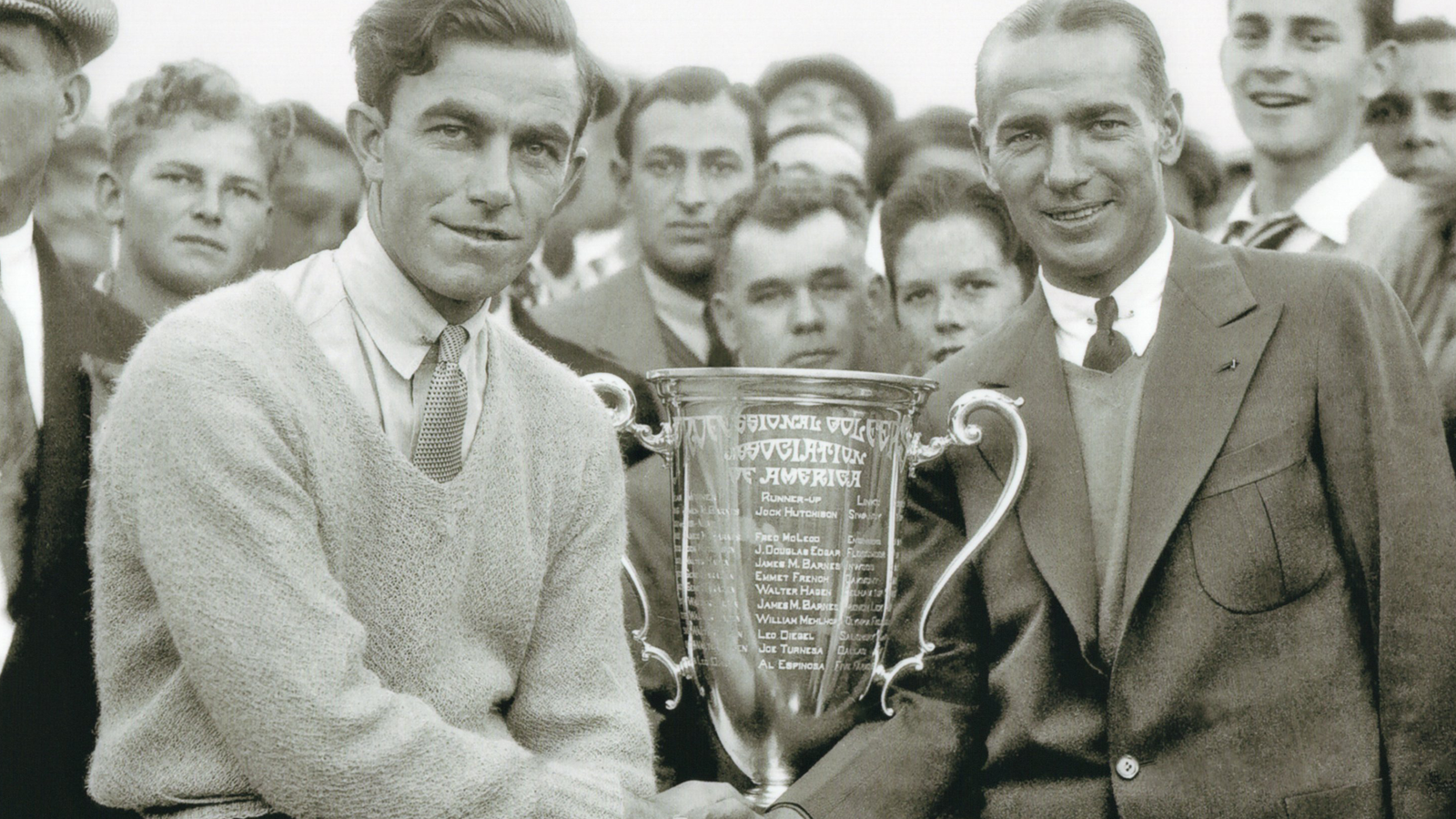
Johnny Farrell and 1929 PGA Champion Leo Diegel posing for the first time with the new PGA Championship trophy.
Beaming this time with an unforced smile, Leo Diegel earned his second straight championship, and finally, a PGA Championship trophy to care for. Alex Pirie played another bad lie back into the game, and even Walter Hagen was impressed. Later that week, a grand dinner in the Blossom Room of the Hollywood-Roosevelt Hotel brought out the stars. Hagen and his fellow professionals joined with Hollywood moguls to reenact Diegel’s award ceremony, as if to make up for the 1928 shortfall.
The next year, defending champion Diegel and the trophy journeyed together across the country to Long Island, New York. Fresh Meadow Country Club was the host club, and the scene of the 1930 championship. Missing from the action this year was the incomparable Walter Hagen. He failed to qualify in the regional medal rounds, and found himself with some unaccustomed "free time." Diegel was eliminated in the early rounds, and in the finals Tommy Armour prevailed over Gene Sarazen on the 36th green, to win 1 up. The R Wallace Perpetual PGA Championship Trophy was presented with fanfare the afternoon of Sept. 13 by new PGA Administrator, Albert Gates.
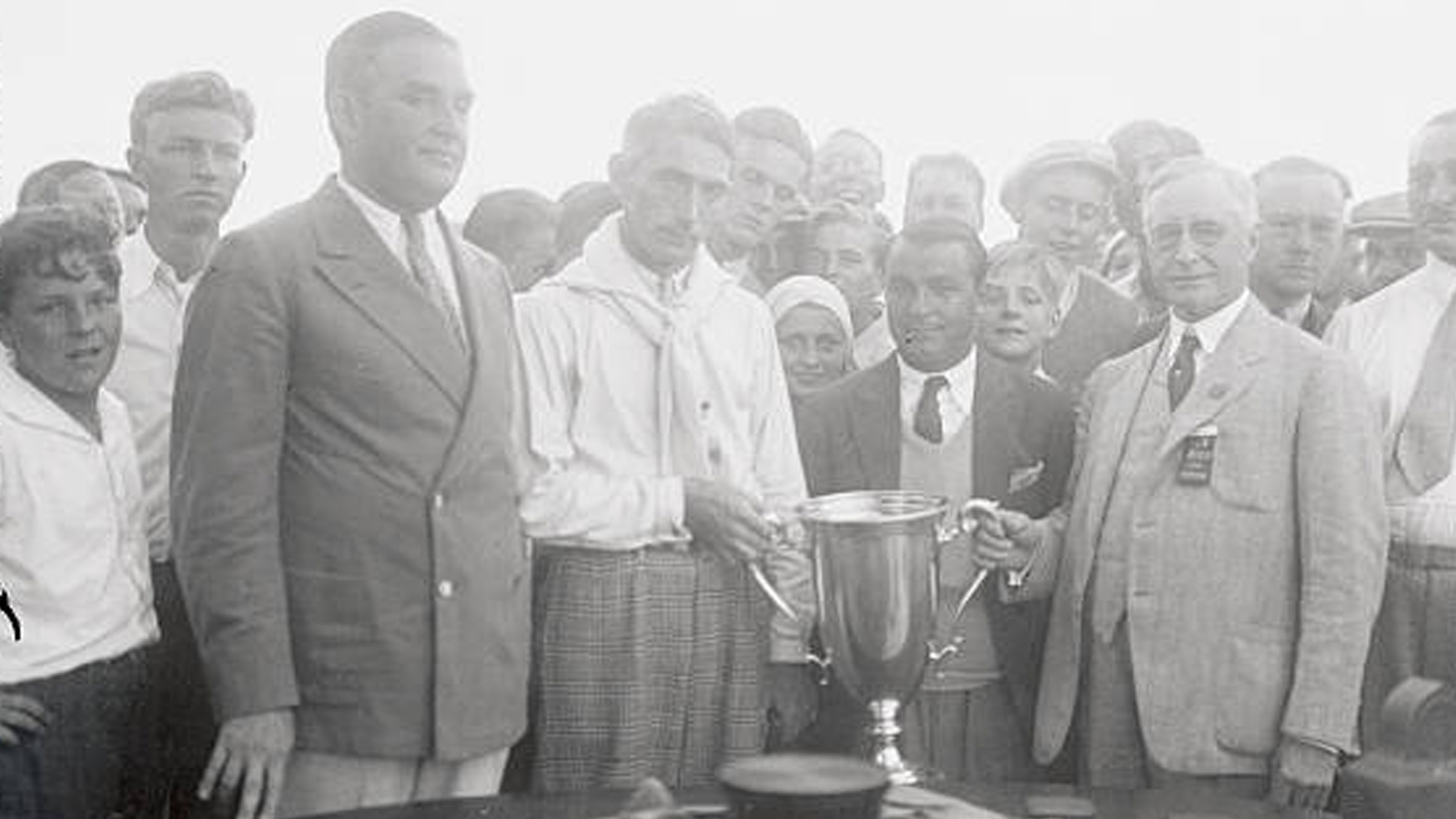
Left to right: Benjamin Ribman, President of Fresh Meadow, Tommy Armour, Champion, Gene Sarazen, Runner-Up, Albert Gates, PGA Business Manager, and the Perpetual Championship Cup.
Tam-O-Shanter Country Club in Rochester, Michigan, was Tommy Armour's home club, and they were over the moon that their man won. They immediately began planning a celebration to welcome the champion and his trophy. On Sept. 25, Tommy's club threw a grand party and golf tournament. Hagen was in the neighborhood, and invited, as Armour now joined him in calling Michigan home. A surprise to no-one, Hagen won the casual tournament. He was using his extra free time well. The very next week, Hagen surprised himself with a discovery to change the course of PGA history.
October 6th, 1930
NEW YORK EVENING JOURNAL
HAGEN FINDS LOST P.G.A. TROPHY.
“In Detroit last week. Hagen, while going through some old trunks, unearthed a bulky package. Lo, and behold! It was the P.G.A. trophy which had been lost and was found again! Now the problem is what can Hagen do with the mug?"
In another made-for-Hollywood plot twist, over the last many days, both PGA trophies were now residing in Michigan, and only miles apart. While the papers could speculate "what can Hagen do with the mug," Alex Pirie didn't see the humor in it. The Wanamaker Trophy was quietly shipped to the Chicago office of Pirie and Albert Gates. The 1930 PGA Annual Meeting was being hosted in Chicago in just a few weeks, and decisions could be made then.
The meeting opened, and first things first. After 10 dedicated years of volunteer service to the PGA, the last four strenuous years as President, Alex Pirie was stepping aside. He received a spirited ovation and generous gifts ceremoniously presented by his dear friend, Pat Patterson. He was unanimously bestowed with the title, Honorary President.
The New York Evening Journal 1930 report was followed six months later by an Associated Press mention on April 22, 1931, attributing its “news” anonymously to “one of the Florida golfing scribes" who wrote, “This fall, when a porter was cleaning up the golf factory in Detroit, which makes the Hagen equipment, he found an unopened sealed package. In it was the cup. Just how it arrived in the factory basement still remains a mystery.”
The factory was owned by L.A. Young & Company, which had purchased the Walter Hagen Golf Products Corporation in 1925.
The reemergence of the Wanamaker Trophy was kept as quiet as possible, and Pirie was given one additional assignment: assist in promoting an Alex Smith memorial tournament.
Smith was known to all in attendance, and his death earlier that year was met with deep sadness. To many in the meetings, and the entire executive committee, Alex was a crucial leader in professional golf from the day he arrived from Carnoustie, Scotland in 1898. Wins in two U.S. Opens, two Western Opens and four Metropolitan Opens were only the start to his resume.
In another made-for-Hollywood plot twist, over the last many days, both PGA trophies were now residing in Michigan, and only miles apart . . . the Wanamaker Trophy was quietly shipped to the Chicago office of Pirie and Albert Gates.
His students, Jerry Travers, Marion Hollins and Glenna Collett, credited him for their success. For decades, his fellow professionals followed his lead as he fought tirelessly for proper treatment and sufficient purses in the early American professional tournaments. Walter Hagen also knew him well, from a young age, watching and learning much.
When asked about his brash style of quickly studying and striking his putts in match play, Hagen would warmly say, “I learned that from Alex Smith!”
Now, because of Hagen’s past transgressions, there were two PGA Championship trophies, and a separate plan to honor the memory of Alex Smith. The executive committee partnered with generous donors to create the Alex Smith Memorial Medal, to be awarded each year to the medalist qualifier for the PGA Championship.
In a natural next step, the R. Wallace Perpetual PGA Championship trophy was ordered to be re-engraved, to read “Veterans Memoriam Alex Smith, 1930”. Official rules for the trophy, "Custody for one year of the Alex Smith Memorial Trophy, a beautiful cup, provided by the Association to commemorate the name of the late Alex Smith is given to the tournament medalist."
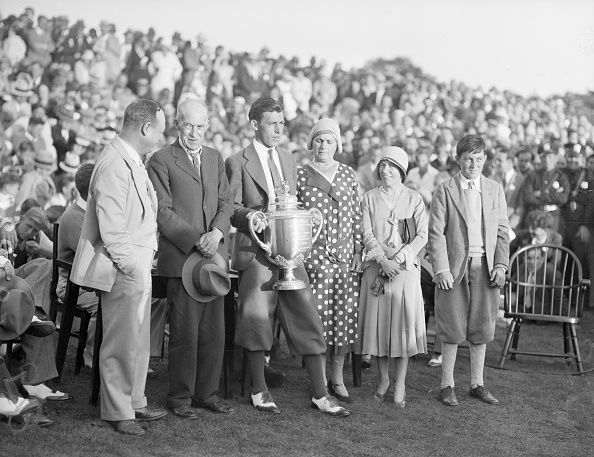
The Wanamaker reappears in the winner’s circle for 1931, raised at Wannamoisett Country Club by Champion Tom Creavy.
At the 1931 PGA Championship hosted at Wannamoisett Country Club, Rhode Island, the Wanamaker re-appeared in its rightful place for the first time since 1925. In a formal championship ceremony, Champion Tom Creavy grabbed the Wanamaker Trophy with gusto. Also appearing? The Alex Smith Memorial Trophy to the medalist.
Gene Sarazen earned the honor, and his name was the first engraved on this new version of the trophy. Appropriate after all, since Gene’s name as prior PGA Champion and runner-up was literally just removed from the trophy during the re-engraving. Four years later, the same happened with Hagen, medalist in 1935, and his name placed back on the trophy.
In future years, a Who’s Who of golf earned a permanently engraved place as well. Names like Ben Hogan, Sam Snead (twice), Byron Nelson(three times), Claude Harmon, Lloyd Mangrum, Jim Ferrier, Doug Ford, the Dutra brothers and Dutch Harrison(twice). In 1955, after 27 years of service, the trophy was retired, with the elimination of same-week qualifying for the PGA Championship.
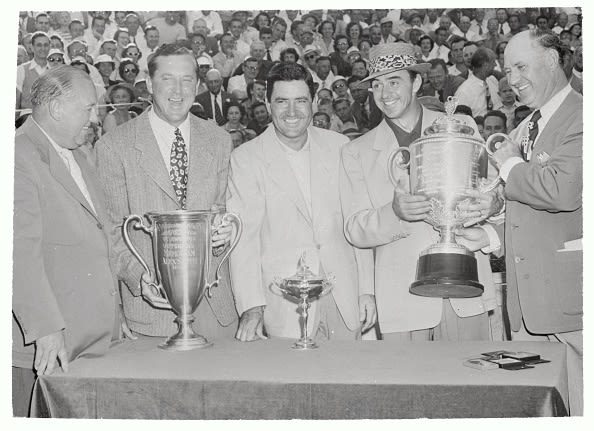
Left to right: Tom Utterbeck, Hermitage Country Club; Ray (Wade) Hill, Medalist; Johnny Palmer, Runner-Up; 1949 PGA Champion Sam Snead; and Joe Novak, PGA of America President.
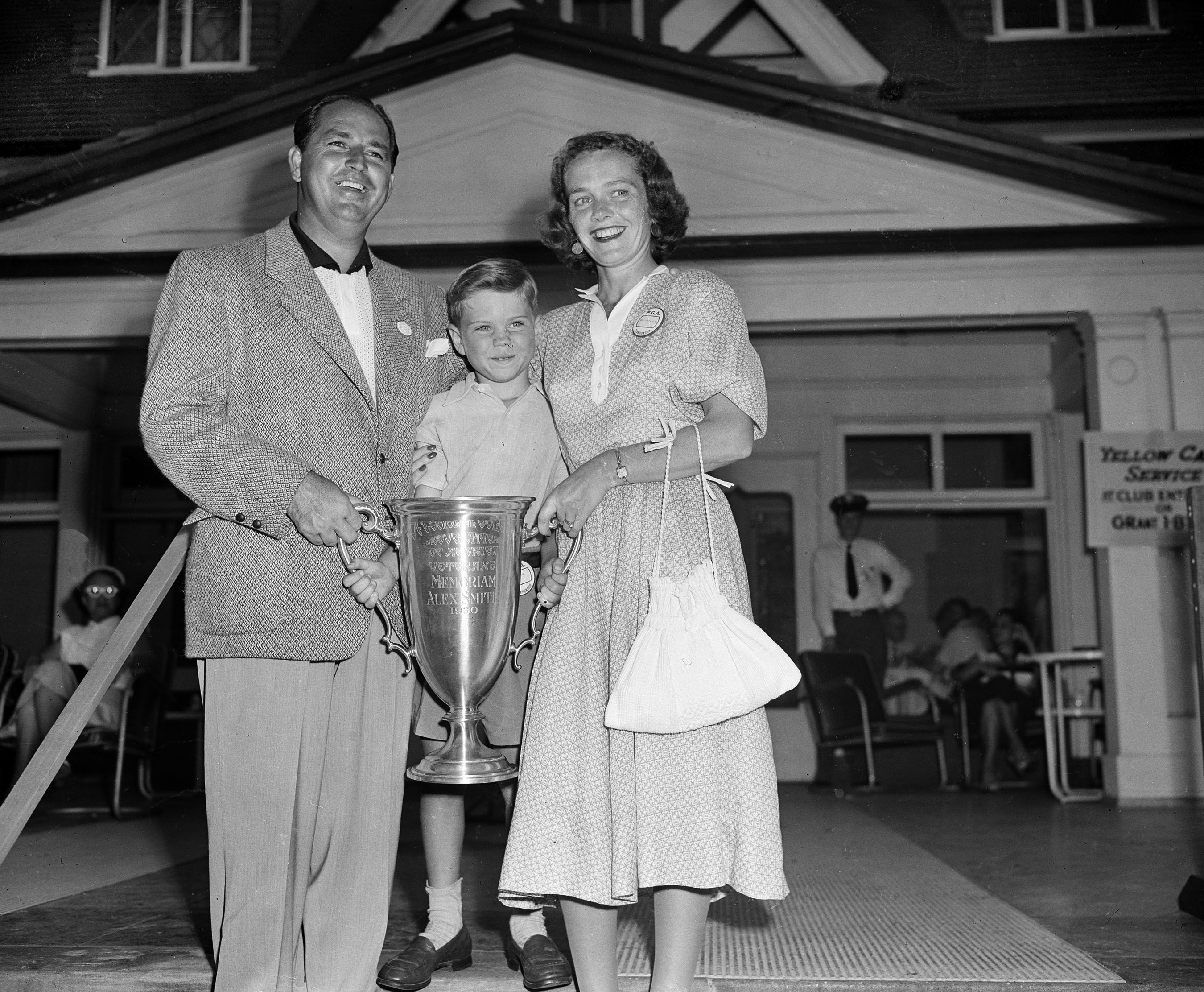
1951 Medalist, Claude Harmon celebrating with son Butch and bride Alice at Oakmont Country Club.
Looking back to 1928, there was nothing Alex Pirie could do about the missing Wanamaker, but that didn’t mean there was nothing he could do. Job well done, Mr. Pirie. The PGA of America owes much to its early pioneers, and Alex Pirie finds himself near the top of the list.
Today the retired Alex Smith Memorial Trophy joins the 43 Championship Medals won by PGA of America Hall of Fame brothers Alex and Macdonald Smith. Two of Carnoustie Golf Club’s favorite sons, they bequeathed their medals to this club of their childhood with a high purpose: “to inspire young stirring in golf to similar lofty levels of achievement," a mission carried on by the Smith Society to this day.
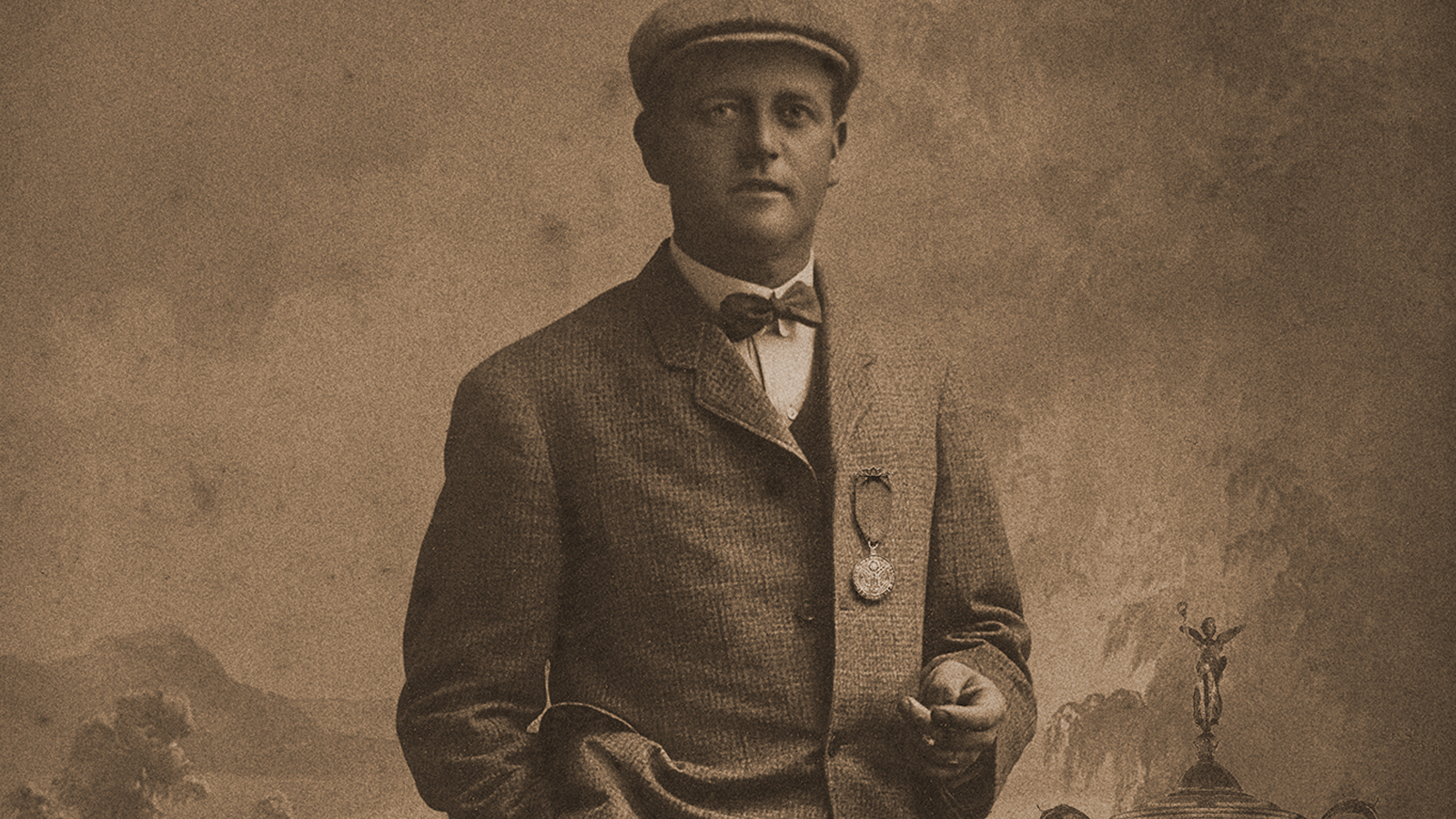
Alex Smith.
David A, Mackesey is the Historian for Carnoustie Golf Club in Scotland and Diablo Country Club, in California, as well as Historian and Curator for The Club at Lac La Belle in Wisconsin. He is Co-Founder, along with Bill Thompson of The Smith Society. PGA Historian Emeritus Bob Denney contributed to this story.

